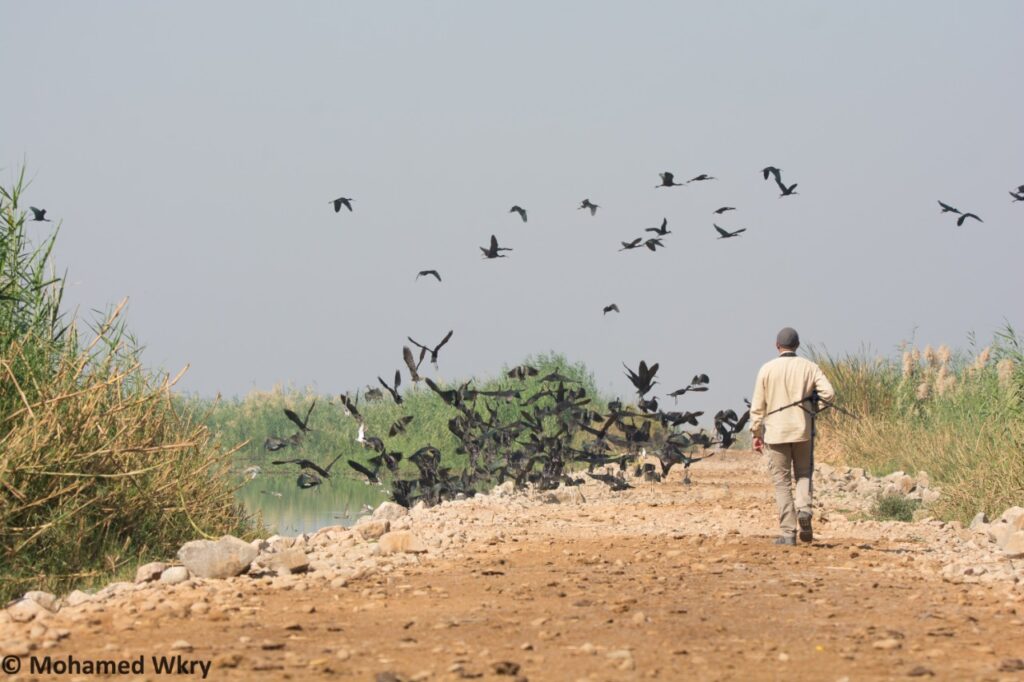Wetlands study portends hope for migratory birds in Egypt

Since 2005, Nature Conservation Egypt (NCE), BirdLife Partner in Egypt has been involved in protecting migratory bird species in the country. Through specialized scientific research, advocacy, education and outreach, NCE supports species, their habitats, and local communities.
By Tariq Abdalla
Every year more than 1.5 million migratory birds fly over Egypt in their migration journeys. The country is uniquely located along the Rift Valley/Red Sea Flyway -one of the most important routes of the Africa-Eurasia Flyway system- with birds moving from wintering grounds in Africa to breeding grounds in Europe and Central Asia and vice versa. In total, 37 species of soaring birds (raptors, storks, pelicans and some ibis), five of which are globally threatened, regularly use the flyway.
As they transverse continents, migratory birds rely on water and habitats including wetlands for migration, breeding and wintering. Although known as the Gift of the Nile, Egypt is in fact a hyper-arid country that has limited areas of wetlands. These wetlands host a number of migratory bird species in the country including the Northern Shoveler (Spatula clypeata), Ferruginous Duck (Aythya nyroca) Mallard (Anas platyrhynchos), White Stork (Ciconia ciconia), Glossy Ibis (Plegadis falcinellus) and different species of egrets and waders. However, these wetlands are increasingly threatened by various factors including a growing population, land reclamation, and climate change among others.

Since 2005, Nature Conservation Egypt (NCE), BirdLife Partner in Egypt has been involved in protecting migratory bird species in the country. Through specialized scientific research, advocacy, education and outreach, NCE supports species, their habitats, and local communities. In January 2021, NCE began conducting a national scale study to assess the potential of Water Treatment Plants (WTPs) in supporting resident and migratory wildlife, especially birds, as well as functioning as carbon sink buckets in the Sahara.
“In arid landscapes, wastewater treatment sites seem to provide very valuable and suitable habitats for migratory birds. In Egypt, more than 100 million people compete with wildlife over the very limited wetlands. However, wastewater sites stand as undesirable wetlands by humans but very attractive to birds”, said Khaled Elnoby, NCE’s Executive Director.

Through this study, NCE has determined that WTPs support a great diversity and abundance of bird species including residents and migratory birds. Further, they have a high potential to act as wetlands, and by doing so, mitigate the effects of climate change by absorbing carbon from the atmosphere.
“Since the 1970s, the world has lost 35% of its wetlands. Despite the critical role they play to human and planet life, wetlands are disappearing faster than forests. This ground-breaking study by Nature Conservation Egypt is thus timely, and its findings have the potential to immensely benefit nature and people”, said Dr Kariuki Ndang’ang’a , Regional Director for Africa, BirdLife International.
In addition, the well managed WTPs can be used as recreational areas and public spaces for Egyptians. Currently, NCE is engaging with various authorities in the country, to promote the value of these sites for birds and wildlife. “NCE looks forward to seeing more integrated management approaches for waste water treatment sites in Egypt”, concluded Elnoby.
“In arid landscapes, wastewater treatment sites seem to provide very valuable and suitable habitats for migratory birds”Khaled Elnoby, Executive Director, Nature Conservation Egypt
